IARJ global conference in the U.S.—Cultivating Understanding, Accuracy and Empathy in a Polarized World
Iranian journalist Fariba Pajooh spent months in solitary confinement in a prison cell in her own country that was no bigger than a closet. She was blindfolded when taken to the bathroom, so she would not see other people. Her world was enveloped in silence and fear.
Pajooh’s crime? Treason—for writing reports about Iran for Radio France Internationale (RFI).
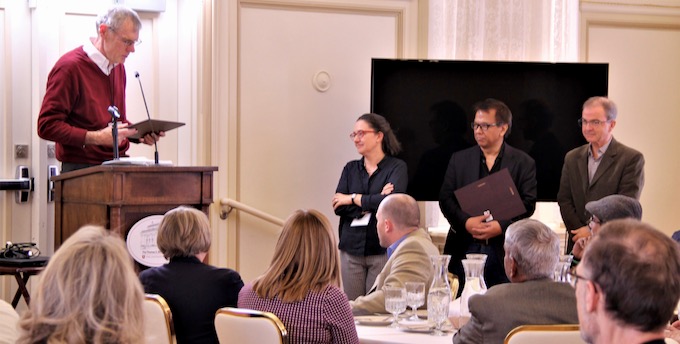
Still, there are many other stories to tell about faith in Iran, the amiable reporter said as the keynote speaker at the first North American meeting of the International Association of Religion Journalists (IARJ) in October.
Some 28 religion writers from across the United States and a dozen other countries —including Canada, Germany, India, Indonesia, Iran, Italy, Malaysia, Mexico, Norway, Pakistan, Serbia, Spain and Sri Lanka — gathered in Salt Lake City (Utah, United States) for a two-day conference on Cultivating Understanding, Accuracy, and Empathy in a Polarized World.
Meeting at the University of Utah’s Kem C. Gardner Policy Institute, the participants engaged in conversations that were multidimensional and wide-ranging.
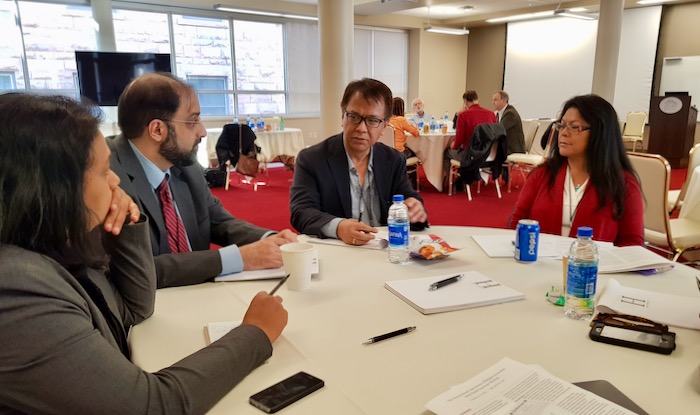
Two reporters of US newspapers, Niraj Warikoo of the Detroit Free Press, and Deepa Bharath of the Orange County Register, joined Waqar Gillani of Pakistan’s The News on Sunday to explore the role of religious minorities.
Bharath, who covers religion in the Los Angeles area, grew up in India in a traditional Hindu community, and when she started working she was one of the very few women of colour.
“Mine is a unique condition to be in: covering minority communities as a minority reporter,” she said. “It has been a very interesting experience to me covering minority communities as a person of color.”
She experienced the disadvantages but also the advantages of being a migrant herself. People are more welcoming, they don’t feel intimidated by me,
she said. I approach them with a learning attitude and humility.
The attitude in approaching communities can be crucial when reporting on minorities, as Warikoo stressed. Covering religion needs curiosity, empathy, but you also have to be honest—you have to be a truth teller.
When a religion is dominant, it’s very challenging to cover minorities, due to pressures from editors and from the society leaders.
Gillani added, describing the situation in Pakistan. Being balanced is the biggest challenge in regions like South Asia, especially when you are covering religious persecution or blasphemy.
Gillani experienced at first-hand what that means: I was told I should not report on that because I am a Muslim.

On one panel, Peter Smith of the U.S.-based Pittsburgh Post-Gazette, noted, I often wonder: Who is missing in our coverage? Now we hear voices that we never heard before, because now we have social media. Now we get more complicated stories.
Several participants analyzed what it takes to tell compelling stories.
Sally Stapleton, Associated Press global religion editor, described how her former paper, Pittsburgh Post-Gazette, won a Pulitzer Prize for its coverage of the shooting at the Tree of Life synagogue. She talked of building trust with the Jewish community and with victims’ families and using sensitivity in photographs.
Sometimes the best stories are the words of our sources,
Stapleton said. And sometimes they are told in pictures, not words.
Jelena Jorgacevic of Serbian magazine Vreme spoke of several religious stories in Serbia, and opposition to bringing them to light.
Leaders of the Orthodox Church in Serbia,
Jorgacevic said, perceive media and journalists either as messengers or as enemies.
For Uday Basu, of India’s The Statesman, journalism is a mission. Our job is to tell the people’s stories,
he said, recounting the experience of a hapless [Muslim] youth who was mobbed by some Hindu zealots and subjected to merciless beating for seven hours as he refused to sing the praise of the Hindu god incarnate Sri Ram.
The police were slow to arrive, the journalist said, and the Muslim died four days later. Then the government claimed the death was caused by cardiac arrest.
It was up to the news media to discover the truth of what happened, Basu told the audience. The young widow backed by the media has resolved to fight to the end for justice for her husband slaughtered for a gross distortion of religion.
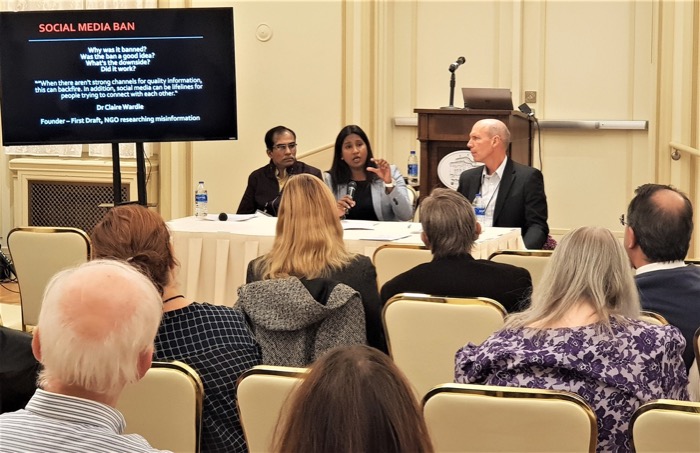
A centerpiece to the October conference was the public lecture, Understanding religious biases in reporting on national and international conflicts, sponsored by ARDA (The Association of Religion Data Archives).
The session opened with a presentation by Roger Finke, ARDA’s director and a professor of sociology, religious studies, and international affairs at US Pennsylvania State University.
The response to civilization divides, and not the divides per se, explains the religious conflict that might result,
Finke said on the dynamics of religious persecution and conflicts, while focusing on how journalists can help develop a better understanding of religious groups.
Basu offered a look at religious conflict in India, and Indeewari Amuwatte, anchor for the English-language TV station, Ada Derana 24 TV, in Sri Lanka, shared her experience covering the horrific Easter massacre in Colombo and other places in the country.
Amuwatte discussed the need for the station to offer only verified facts, knowing that any false rumors could cause religious violence.
The big challenge for us was the misinformation and fake-news which were circulating in social media,
Amuwatte said. It was all live-streamed on social media, where you could see bodies in pieces, but we decided not to run those images. We tried to get time to report. We were not publishing any comments or rumors.
The second day of the conference opened with a conversation between Jewish, Muslim and Christian reporters about the volatile mix of politics and religion.
Gillian Friedman of The Deseret News in Salt Lake City cautioned journalists not to lump all Jews together, religiously or politically. There is not one Jewish political position, she said. So reporters should get an array of thoughts on any one issue.
The biggest threat to religious freedom in Indonesia, population 264 million, is its decades-old blasphemy laws, according to Endy Bayuni, a senior editor at The Jakarta Post.
Hundreds of people have gone to jail under this law, on the pretext that they have insulted religion. A Buddhist woman was given a two-year jail term under the blasphemy law for complaining about the sound of the call to prayer from a mosque near her home.
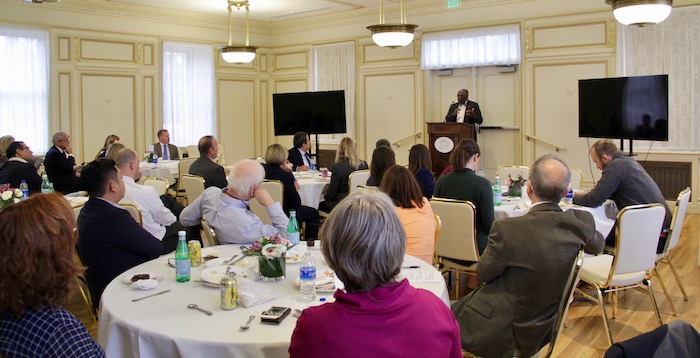
On the topic of religious freedom, Patty Talahongva, news executive at the U.S. newspaper, Indian Country Today and a member of the Hopi tribe, challenged the reporters to see inherent conflicts for Native Americans. Take the case of eagle feathers. They are sacred to many different tribes and used in religious ceremonies, but they are protected from use by environmental groups.
What is religious freedom to one group,
Talahongva said, may be seen as discrimination by another.
Other panels included why some religious conflicts get more international attention than others, and the role of religion in coverage of migrants and refugees with a focus on the current situation in Europe and in Mexico.
I believe that while it is up to us to cover the situation of migrants, the circumstances in which they arrive, and how governments make efforts to welcome them or not welcome them,
David Ramos of Catholic ACI Prensa said, stressing the importance of considering migrants and refugees as human beings.
We should seriously consider reporting on how to help, and how in fact various organizations, many of them religious, are deploying great efforts to execute projects that give opportunities for migrants to stay in their countries,
Ramos said, not as an
anti-migrant
measure, but rather what most of them want: their homeland, their home, their family, their culture.
The panel hosted a lively discussion on coverage on migration: the media language in addressing these issues, hate-speech, the role of journalists and whether it’s worthwhile for newsroom to follow guidelines on covering migration.
A luncheon was the setting for IARJ’s first induction into its Hall of Fame.
Two awards were given. One went to the late Anthony Shadid, who wrote for AP, The Washington Post, and The New York Times. The other went to Maria-Paz Lopez, one of IARJ’s founders and its first president, who is a foreign correspondent in Berlin for Spain’s La Vanguardia.
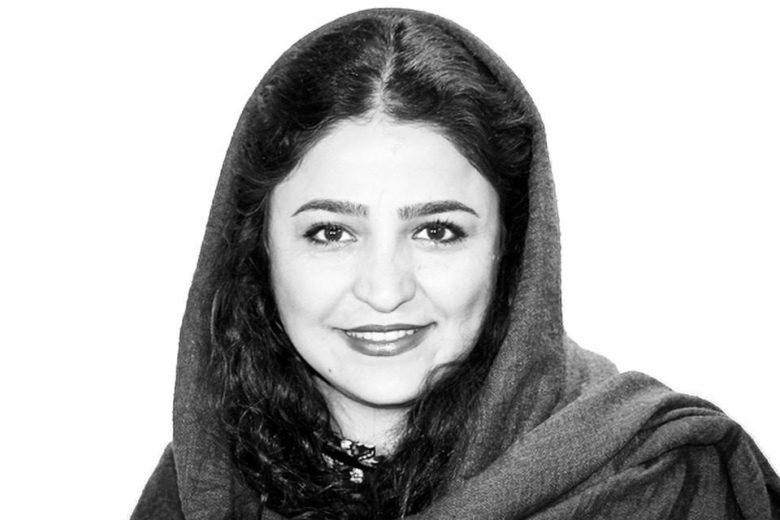
The pen is the enemy of ignorance, she wrote in her blog, a few days before being arrested and imprisoned, on August 22, 2009. In her powerful speech, she shared her background and experiences in prison as well as her work on non-governmental agencies working for women’s rights, discussions between
religious scienceStudies, top Islamic leaders, and the development of Shi’ism in Iran and Iraq.
Pajooh was the featured luncheon speaker, who spoke hauntingly of her time in an Iranian prison as well as about the work on non-governmental agencies working for women’s rights, discussions between religious science
students and top Islamic leaders, and the development of Shi’ism in her country.
The conference ended with a discussion among participants of how to collaborate with one another, to avoid prejudices that might affect their stories, to recognize and honor the work that is already being done and to build and extend IARJ’s global network of religion journalists.
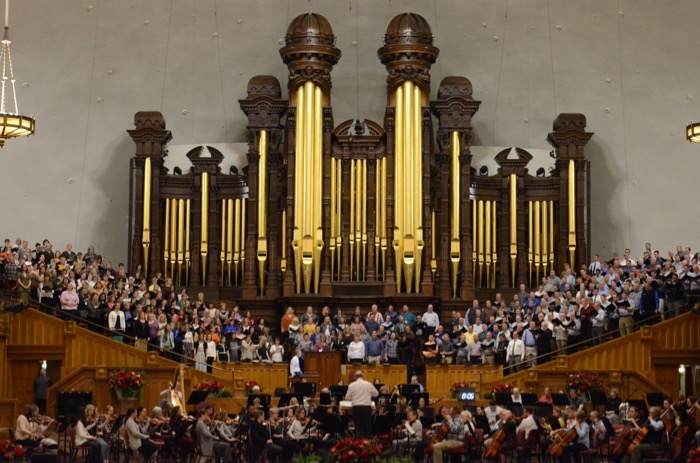
The conference,
Cultivating Understanding, Accuracy, and Empathy in a Polarized World,was financially possible thanks to the generous support of donors and sponsors: The Khosrow B. Semnani Family Foundation, Orrin G. Hatch Foundation, Brigham Young University, The Church of Jesus Christ of Latter-day Saints, Sam and Diane Stewart Foundation, The Episcopal Diocese of Salt Lake City, The Catholic Diocese of Salt Lake City, Dinesh Patel and the Sri Ganesh Hindu Temple.
